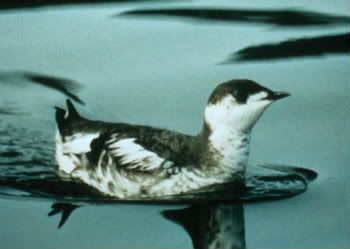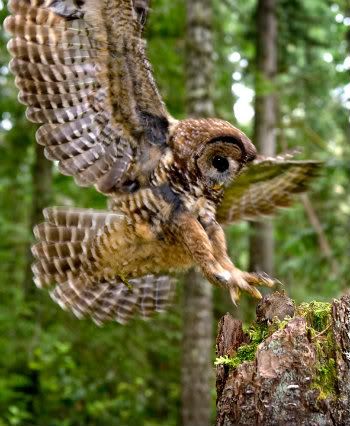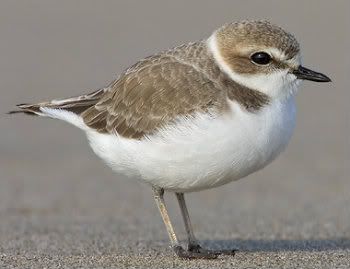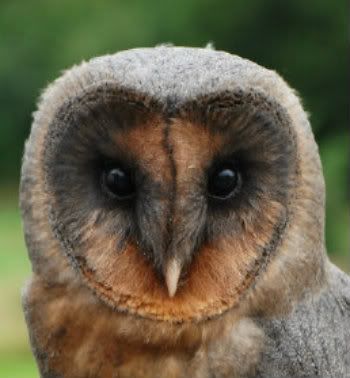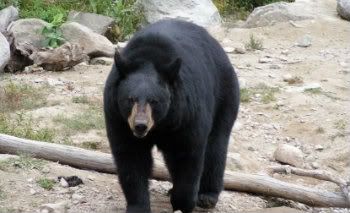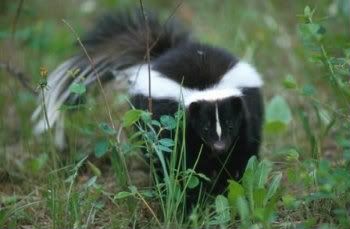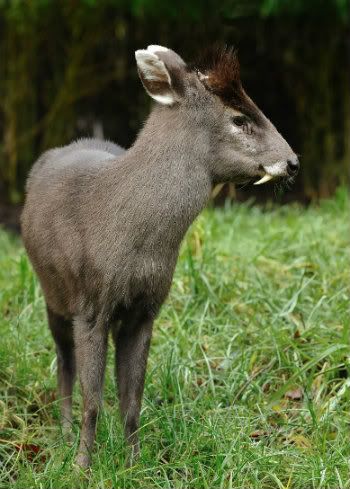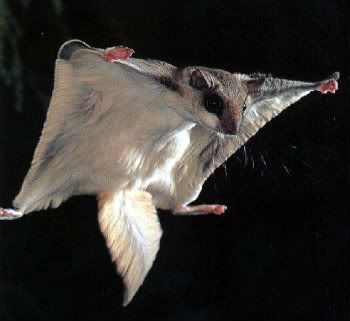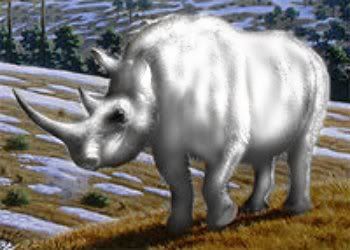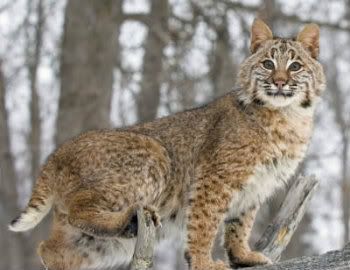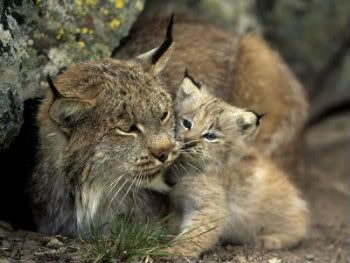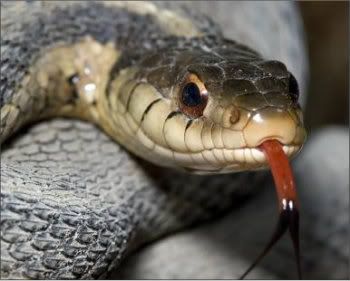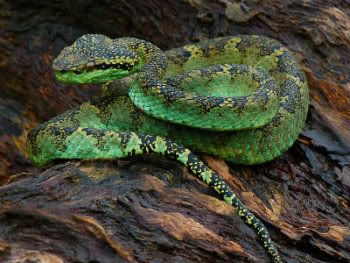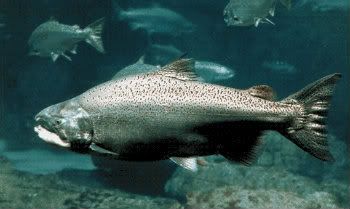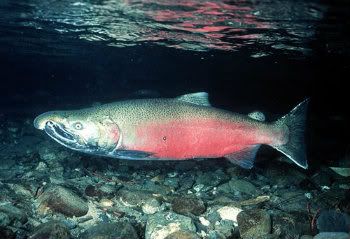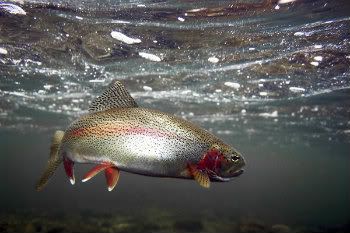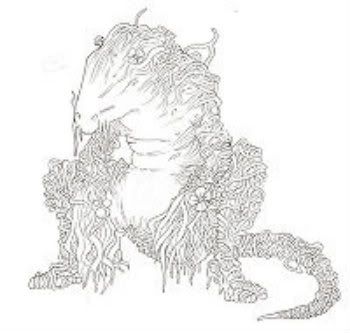
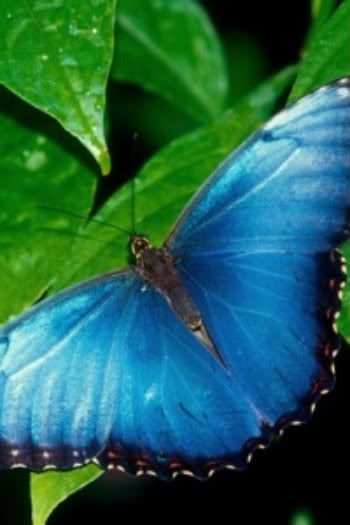 Name: Hahk'Loa Characteristics: Name: Hahk'Loa Characteristics:The Hahk'Loa is a native butterfly of the Temple of Caiyha at the Spires. It is known for its phosphorescent coloring, its mood altering secretions, and its lethal poison. This creature is considered sacred by all native Spirians. Any found purposefully harming one will receive one of the Judgments. *Credit to Tiki
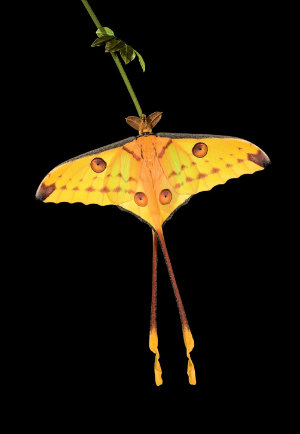 Name: Name: Talderan Dancing Moth Frequency: Medium Threat level: Medium Major features: Bright yellow coloring, backward antennas, eyeballs on wings. Abilities: To disinfect a wound Most common in: Only on the Petal of the Silver Crescent Physical characteristics: The Talderan Dancing Moth is a smaller moth with a wingspan of only one foot. The length is nearly three feet. Males are the same size but black in color. The antennas are located on the back of the butterfly, not the top, and are nearly two feet in length. The all brown body is located under the wings of the moth.
There are only two wings on the moth and they are the exact same. There are two sets of eyes on the moth and both are orange with black pupils. Two lines of orange dashes lay in the middle of the wings. Another set of eyes rest below these. Purple decorates the corners of the moth's wings.
Upon flying high, the Talderan Dancing Moth will tumble down to the ground below. They always pull back up before smacking against the earth. Their movements make it look as though they are dancing in the sky. Social Structure: There is no social structure within the Dancing Lantern with the Talderan Dancing Moth. All moths harmonize together. Miscellaneous: The Talderan Dancing Moth has the ability to disinfect a wound and are attracted to those with open sores. Patients from Nature's Nurture are regularly brought to the Dancing Lantern by assistants. Those who smell like blood, however, will have the dancing moth land on them and try to heal them. This can lead to a sore forming from the particles the moth uses to cleanse a wound. Any injury caused by the moth can only be disinfected by the moth.
*Credit to Lixue
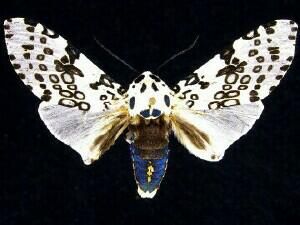 Name: Name: Talderan Snow Moth Frequency: Medium Threat level: High Major features: Spotted wings, teeth. Abilities: Can bite, has venom. Most common in: Only found on the Petal of the Silver Crescent Physical characteristics: A female moth can have a wingspan of half a foot and a length of half a foot. The male is nearly half as small. The body is short and stocky. The head is pure white with blue circles . Behind this, there is a thick brown stripe followed by blue. Yellow and white reside on the blue.
There is one set of wings with one white web behind. This helps the moth slow down and also stick to its victim. The top set of the wings are all white with black rimmed circles. The antennas are grey and only three inches in length.
Social Structure:The Talderan Snow Moth lives in clumps of up to twenty moths. They generally live inside a bush and post "lookouts" as a bee nest would. The watchers will alarm the group if someone is too close and all but the female leader will attack. The female leader does nothing besides find the home and if removed, the rest will leave as well. Miscellaneous: The Talderan Snow Moth is extremely territorial. They will claim an area, normally a bush of some sort, as their home. Any who wander too close or try to touch the bush are attacked. The moth bites the victim with small fangs and injects a poison that leaves the person dizzy. If the venom is not sucked out within a bell's time, the individual will suffer from hallucinations for up to two weeks. There will also be a high fever. *Credit to Lixue
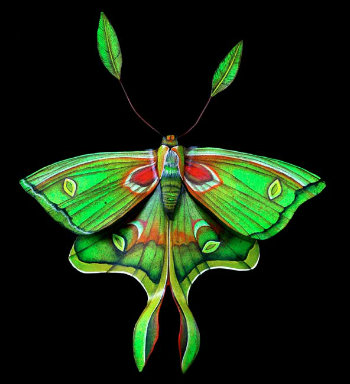 Name: Name: Talderan Glowing Moth Frequency: High Threat level: Low Abilities: Glows Most common in: Only on the Petal of the Silver Crescent Physical characteristics: The Talderan Glowing Moth has a wingspan of three feet and is nearly two feet long. The antennas are the length of a Jamoura's middle finger and have leaf-like petals at the end. The female moth is nearly a foot larger than the male. The body is a myriad of colors, ranging from yellow to blue to green. The moth has two sets of wings, one top and one bottom.
The top set are fluorescent green. Near the body, red extends to form a shape akin to a thumb print. This is surrounded by grey before extending into green. Near the end of the wings, there is a single diamond shaped yellow dot followed by a black line. Each wing is nearly half a foot in width and extend outward.
The bottom set of wings extend downward and have droplet shaped tips. Together, the wings look like a face. There is a set of blue eyebrows with diamond shaped green eyes. The "nose" consists of a lighter shade creating a line around the wings.
The Talderan Glowing Moth has the ability of "misting". This means, when in danger or angered, the moth will shake rapidly and tiny particles of green will fall onto the predator. Besides being incredibly itchy, the particles will dye the wearer a glowing green for nearly two weeks. Social Structure: The Talderan Glowing Moth lives in harmony with other creatures. There is no higher caste, nor is there a dominant race. Miscellaneous: The Talderan Glowing Moth does not attach to visitors at the Dancing Lantern, nor will it ever. This is the most prominent moth at the Dancing Lantern. *Credit to Lixue
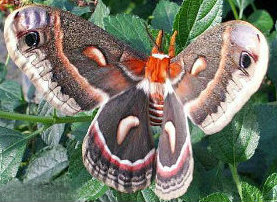 Name: Name: Talderan Redwood Moth Frequency: Medium Threat level: No threat Major features: Humongous size, child-like cry, known for "attaching" to visitors at Dancing Lantern Abilities: None Most common in: Only on the Petal of the Silver Crescent Physical characteristics: The Talderan Redwood Moth is the biggest moth in the Taldera region. It can grow to nearly six feet wide and five feet long. The antennas are thumb length long and the body nearly a foot in length. Both the female and the male are the same size and coloring.
The body is a mixture of orange and white. A white line covers the face before melting into flourescent orange which goes until halfway down the body. Another white strip and a patch of orange. The orange and white flip-flop back and forth on the end of the body.
The wings are in sets of two and barely differentiate. All wings are brown, orange, and white. The orange fades at the top of the body out onto the wings themselves before blending into the brown. Bean shaped white spots are tinged with orange closest to the body. A pumpkin colored line separates the next section. The top set of wings dissolves into white squares. The bottom set falls into a lighter brown with black lines. Social Structure: The Talderan Redwood Moth has no social structure. They harmonize with all moths and people. Miscellaneous: The Talderan Redwood Moth is the most likely butterfly to "attach" to a visitor at the Dancing Lantern. It has been known to prefer children for this behavior. The moth is also extremely picky in the people it bonds to. *Credit to Lixue
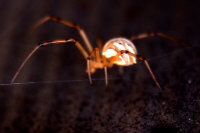 Name: Name: Spirian Marble Spider Frequency: Medium Threat level: High Major features: Eight legs, marble rear, large webs Abilities: Change color with the weather Most common in: Only on the Petal of Eternal Warmth Physical characteristics: The Spirian Marble Spider is rarely found off of the Petal of Eternal Warmth. This is a good thing, given the risks associated with the spider, including death.
The leg length of the spider may be up to six inches. All eight legs are a burnt shade of orange with black stripes near the joints. The body is a tan and sixteen eyes are all black. Two pinches lay at the end of the face. The rear is a large white ball, about the knuckle size of a Jamoura, and is splattered with orange lines. Males and females do not differentiate.
In "Normal" weather, the Spirian Marble Spider will only glow on its rear, a bright white. 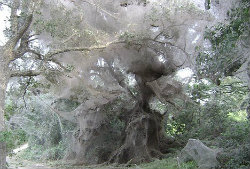 Social Structure: Social Structure: In groups of hundreds, the spiders will specifically choose a certain tree and, within two days, cover it in webs. The Marble Spider will not move from the tree or spread in the foliage. On the Petal of Eternal Warmth, there are only three groups. These creatures can capture prey up to twenty five pounds. With teamwork, the Marble Spider can carry prey up to three hundred pounds. Miscellaneous: If someone is unwise enough to fall asleep near one of the Marble Spider trees, they risk having their mouths and nostrils webbed closed by a spider. The Marble Spiders will then proceed to move the body back to the home tree. Children are the most likely prey.
*Credit to Lixue
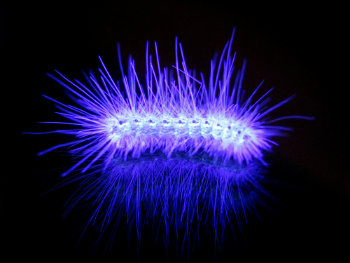 Name: Name: Talderan Glow Point Frequency: Low Threat level: High Major features: Quills, dangerousness. Abilities: To inject a venomous quill, change color with the weather Most common in: Only on the Petal of Eternal Warmth Physical characteristics: The Talderan Glow Point is the least common bug at Glowy Night Delights. It hides underneath bushes and rarely comes out in the day. When it does, it must be either angered or provoked. A difficult task unless the bug is in danger.
The Glow Point differentiates in size by male or female. The males range in length from four to six inches and weigh less than a pound. The females are nearly twice the size. They can weigh up to two pounds and longer than a foot.
On the outside of the Glow Point's body are deep purple quills. These are extremely dangerous and hold venom. The inner body is soft and a light blue coloring. Social Structure: The Talderan Glow Point live in pairs. The female is pregnant nearly nine times a year and gives birth to two offspring. The time to reach maturity is half a season. Before reaching adulthood, the quills are not poisonous. The eggs laid are guarded by the male while the female searches for food. Once the offspring are born, they will feast on their mother until not a crumb is left. Miscellaneous: The venom in the Talderan Glow Point's quills has the ability to paralyze a large Jamoura for up to three hours. A small human child risks death or coma. When paralyzed, the individual is aware of all the happenings around them, but they are not able to speak or move.
*Credit to Lixue
 Name: Name: Talderan Daylight Delight Frequency: High Threat level: Low Major features: Multiple wings, brightly glowing body, colorful wings, glowing antennas. Abilities: To change color with the weather Most common in: Only on the Petal of Eternal Warmth Physical characteristics: The Talderan Daylight Delight is a unique insect. Though its whole body glows, one can only see the body and antennas shine brightly in the daytime. The wings are too thin to truly notice the color.
In total, there are eight wings on the creature. Each wing is exactly alike, creating an optical illusion of a moving rainbow at night. Thin and sticky, the Daylight Delight will "anchor" itself to an object to keep from being blown away. Because of this, it is often found near the ground.
The body of the Talderan Daylight Delight is normally a glowing blue. In fact, the light is so bright no one knows what its actual body looks like. The antennas are long and wispy with a single glowing dot on the end. Social Structure: The Daylight Delight lives a solitary life. It will mate twice a year and lay eggs, but has never show any evidence of being a "family" insect. They seem to have no problem living in groups, if necessary. Miscellaneous: The Talderan Daylight Delight is the most often found bug during the daytime. If a change in weather is arriving, everything on the bug will be a specific color, depending on the weather.
*Credit to Lixue
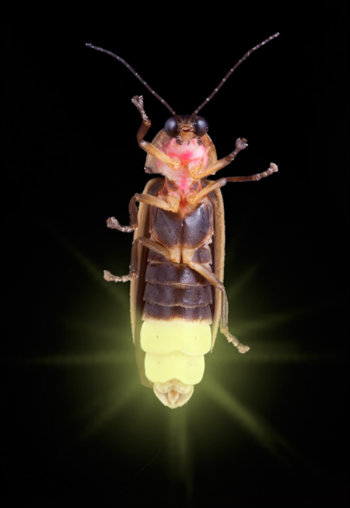 Name: Name: The Spirian Nightlight Frequency: High Threat level: None Major features: Six legs, glowing rear. Abilities: Glows Most common in: The Spires Physical characteristics: The Spirian Nightlight is one of the most common bugs in the Spires. They light up the sky in large numbers and serve as a weather-warning device. The bug has also been lured into paper lanterns around the city. Some of the lanterns are colorful or have designs cut into them. These help light the path at night in an interesting way.
The insect has six legs, and two antennas. A pair of brown wings covers the top of the Nightlight's body. Underneath is shelled and hard. The rear glows yellow in a flashing pattern. The eyes are a reflective black, observing all around them. The face is a red and there are no pinchers. Social Structure: There is no social structure with the Spirian Nightlight. Females may take several partners and males may breed several females. Children are laid in the form of eggs on the bottom side of leaves. Miscellaneous: If an individual crushes the Spirian Nightlight, a yellow residue is left behind. At night, this will glow brightly and last for two weeks. Children will smash the bugs and smear the paste for decoration on their bodies.
*Credit to Lixue | ![]() by Creeper on June 29th, 2012, 5:25 pm
by Creeper on June 29th, 2012, 5:25 pm ![]() by Creeper on June 29th, 2012, 5:26 pm
by Creeper on June 29th, 2012, 5:26 pm ![]() by Creeper on June 29th, 2012, 5:28 pm
by Creeper on June 29th, 2012, 5:28 pm ![]() by Creeper on June 29th, 2012, 5:31 pm
by Creeper on June 29th, 2012, 5:31 pm ![]() by Creeper on June 29th, 2012, 5:33 pm
by Creeper on June 29th, 2012, 5:33 pm ![]() by Creeper on June 29th, 2012, 5:33 pm
by Creeper on June 29th, 2012, 5:33 pm ![]() by Creeper on June 29th, 2012, 5:35 pm
by Creeper on June 29th, 2012, 5:35 pm ![]() by Creeper on June 29th, 2012, 5:36 pm
by Creeper on June 29th, 2012, 5:36 pm 
